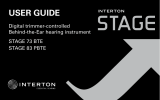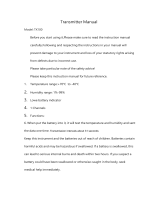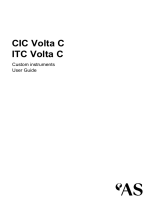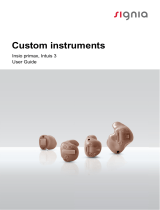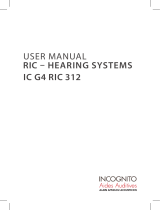Page is loading ...

23
Hearing instrument model:
Left serial number:
Right serial number:
Instrument version:
Completely In the Canal (CIC)
In The Canal (ITC)
In The Ear (ITE)
Microphone in Helix (MIH)
Power version: Standard Power Ultra Power
Battery size: 13 orange 312 brown 10A yellow
Programme Beep Description of when to use
1
2
3
4
Delayed on-activation...............12
Volume control....................20
Push button......................21
Wireless................15, 22, 23, 36
AutoPhone.......................26
Telecoil/Tele-loop system ............31
Power device-exceeds 132 dB SPL ......
SPECIFIC FEATURES SUPPORTED BY YOUR HEARING SYSTEM:
Note: Your hearing system might not support all 4 environmental programmes. Ask your hearing care professional for details.
Ask your hearing care professional to marked options supported by your hearing system.

45
Thank You
Thank you for selecting an Interton hearing system. We are proud of our hearing products and are confi-
dent you have chosen one of the best products available.
Please familiarize yourself with the information in this guide. It contains important instructions for proper
use and care, technical performance information, and other general information about your hearing sys-
tem. Your hearing system has been adjusted to your particular hearing loss. Your hearing health care
professional will explain these adjustments and the special features of your particular model.
All the key features and functions of your hearing system are explained in
video tutorials. To watch them simply scan QR codes and watch the videos
on your smartphone. If you do not have scanning application installed yet you
can go to getscanlife.com on your mobile browser to download free applica-
tion. (ScanLife® is one of the free applications you can use to play QR codes,
you can also use any other QR scanner to play the videos).
Becoming Accustomed to Amplification
While purchasing a hearing system is a major step, it is only one step in a process toward more comfortable
hearing. Successfully adapting to the amplification your hearing system provides takes time and consistent
use.
You will enjoy more benefits from your Interton hearing system by taking the following actions:
• Wear the system regularly in order to get comfortable with using it.
• It takes time to get used to a hearing aid. It may help to begin by wearing your hearing aid for short
periods – even as little as 15 minutes – and then gradually building up your wearing time. In a way, it’s
no different than adjusting to contact lenses. Speak to you hearing care professional, who can design
a schedule tailored just for you.
• As you get more comfortable with the system, increase the wearing time and wear your hearing system
in multiple types of listening environments.
It may take as long as several months for your brain to get used to all the “new” sounds around you. Fol-
lowing these suggestions will give your brain time to learn how to interpret amplification and increase the
benefits you get from using an Interton hearing system.

67
Hearing instrument type designations for models included in this user guide are: Hearing instrument
type designations for models included in this user guide are: Model BO312, FCC ID: X26BO312, IC:
6941C-BO312; Model BO13, FCC ID: X26BO13, IC: 6941C-BO13; Model PH312, FCC ID: X26PH312, IC:
6941C-PH312; and Model PH13, FCC ID: X26PH13, IC: 6941C-PH13. Please see page 12 and 13 for list of
models referring to all types.
Statement:
This device complies with Part 15 of the FCC Rules and IC rules.
Operation is subject to the following two conditions: (1) this device may not cause harmful inter ference,
and (2) this device must accept any interference received, including interference that may cause undesired
operation.
Note: This equipment has been tested and found to comply with the limits for a Class B digital device,
pursuant to part 15 of the FCC Rules and ICES-003 of the IC rules. These limits are designed to provide
reasonable protection against harmful interference in a residential installation. This equipment generates,
uses and can radiate radio frequency energy and, if not installed and used in accordance with the in-
structions, may cause harmful interference to radio communications. However, there is no guarantee that
interference will not occur in a particular installation. If this equipment does cause harmful interference to
radio or television reception, which can be determined by turning the equipment off and on, the user is
encouraged to try to correct the interference by one or more of the following measures:
• Reorient or relocate the receiving antenna.
• Increase the separation between the equipment and receiver.
• Connect the equipment into an outlet on a circuit different from the one in which the receiver is con-
nected.
• Consult the dealer or an experienced radio/TV technician for help.
Changes or modifications can void the user´s authority to operate the equipment.

89
Intended use
Generic air-conduction hearing instruments are wearable sound-amplifying devices intended to compen-
sate for impaired hearing. The fundamental operating principle of hearing instruments is to receive, amplify,
and transfer sound to the ear drum of a hearing impaired person.
List of countries:
Products without wireless functionality are intended for worldwide sales.
In the EU, products with wireless functionality are intended for sale in countries within European Economic
Area as well as Switzerland.
The products are in compliance with the following regulatory requirements:
• In EU: the device conforms to the Essential Requirements according to Annex I of Council Directive
93/42/EEC for medical devices (MDD) and essential requirements and other relevant provisions of Di-
rective 1999/5/EC (R&TTE).
• The declaration of conformity may be consulted at www.resound.com
• In US: FCC CFR 47 Part 15, subpart C.
• Other identified applicable international regulatory requirements in countries outside EU and US. Please
refer to local country requirements for these areas.
• In Canada: these hearing instruments are certified under the rules of IC.
• Cet appareil numérique de la classe B est conforme à la norme NMB-003 du Canada.
• Japanese Radio Law and Japanese Telecommunications Business Law Compliance. This device is
granted pursuant to the Japanese Radio Law (電波法) and the Japanese telecommunications Business
Law (電気通信事業法) This device should not be modified (otherwise the granted designation number
will become invalid)
• This product is a custom-made device.

10 11
Hearing Instrument(s) model and
basic information ........................2
Thank you .............................4
Becoming Accustomed to Amplification .......5
Intended use ...........................8
List of countries . . . . . . . . . . . . . . . . . . . . . . . . . 8
Instruments component identification ........12
On/Off function ........................16
Delayed activation (optional) ...............16
Inserting/ Replacing the battery ............17
Low battery indicator ....................19
Inserting/removing hearing instruments.......20
Volume control (optional) .................24
Push button (optional) ...................25
Flight mode (wireless devices only)..........27
Telephone use ........................29
Listen to radio or TV ....................30
Cellular phones ........................30
AutoPhone (optional) ....................31
Telecoil (optional) .......................36
Tele-loop systems (optional) ...............37
Care and maintenance...................38
Contents
Cleaning Custom made device ............40
Replacing wax filters.....................40
Wireless warnings and precautions
(wireless devices only) ...................42
General warnings.......................43
Troubleshooting guide ...................46
Technical Data .........................54
Warranty and repairs ....................60
Temperature test, transport and
storage information......................61
Hearing instrument expectations ...........62
Warning to Hearing Aid Dispensers (US only) ..62
Important Notice for Prospective
Hearing Aid Users (US only) ...............63
Children with hearing loss (US only) .........64
High sound pressure levels ...............65

12 13
Hearing instruments of type
BO13 are available in the fol-
lowing variants:
C650-MW
C650-MPW
C650-MUW
C450-MW
C450-MPW
C450-MUW
Hearing instruments of type
PH312 are available in the fol-
lowing variants:
CI230-W
CI230-PW
CI230-DW
CI230-DPW
CI330-W
CI330-PW
CI330-DW
CI330-DPW
ST430-DPW
ST430-DW
ST430-PW
ST430-W
ST230-DPW
ST230-DW
ST230-PW
ST230-W
Hearing instruments of type
BO312 are available in the fol-
lowing variants:
C630-MW
C630-MPW
C630-MUW
C430-MW
C430-MPW
C430-MUW
Hearing instruments of type
PH13 are available in the fol-
lowing variants:
CI250-W
CI250-PW
CI250-DW
CI250-DPW
CI350-W
CI350-PW
CI350-DW
CI350-DPW
ST450-DPW
ST450-DW
ST450-PW
ST450-W
ST250-DPW
ST250-DW
ST250-PW
ST250-W

14 15
1. Push button (optional)
2. Battery compartment and On/Off
switch
3. Removal cord (optional)
4. Sound outlet
5. Wax filter
6. Venting (optional)
7. Microphone sound inlet(s)
8. Remote microphone and tubing
(for Microphone In Helix devices)
9. Volume control (optional)
10. Model
11. Manufacturer
12. Serial number
2
7
4
5
9
1
3
12
4
7
1
2
11
10
6
3
8
6
7
4
5
2
7
24
9
1
7
612
10
11 6
4
5
5
6
6
3
Non wireless hearing instru-
ments are available in the fol-
lowing variants:
ST430-DP
ST430-D
ST430-P
ST430
ST230-DP
ST230-D
ST230-P
ST230
ST450-DP
ST450-D
ST450-P
ST450
ST250-DP
ST250-D
ST250-P
ST250
SR1310
SR1210
SR1110
SR1310-P
SR1210-P
SR1110 -P
SR1330
SR1330-D
SR1230
SR1230-D
SR113 0
SR1330-P
SR1330-DP
SR1230-P
SR1230-DP
SR113 0 -P
SR1350
SR1350-D
SR1250
SR1250-D
SR115 0
SR1350-P
SR1350-DP
SR1250-P
SR1250-DP
SR115 0 -P

16 17
Getting started
On&Off function
1. When the battery door is closed, the
hearing instrument turns on, and the
default program will be activ ated.
2. To turn off the hearing instrument, open
the battery door. Many individuals can
use their fingernail to pull it open.
i Whenever the hearing instruments are not in use, re-
member to turn them off to avoid unnecessary battery consumption.
Delayed activation
Hearing instruments can be turned on once you have placed them on your ears. If you prefer to turn them
on just prior to placing them on your ear, your hearing care professional can activate a function called
Scan a QR code with your
smart phone and watch a
instruction video.
On
Off
Delayed on-activation. This function will delay the time in which the hearing instruments turn on by several
seconds after the battery compartment is closed. With Delayed on-activation, a beep will be heard for each
second of the delay period.
Inserting/Replacing the battery
1. Open the battery door completely by using your fingernail.
2. Remove the used battery if present. Insert the new battery
with the positive side in the correct position.
3. Gently close the battery door.
i Always use new Zinc-Air batteries that have a minimum
remaining shelf-life of 1 year.
Scan a QR code with your
smart phone and watch a
instruction video.

18 19
Low battery indicator
Your hearing care professional can set your hearing instrument to give an acoustical indication when the
battery is reaching its end of life. The hearing instrument will reduce amplification and emit a melody if bat-
tery power gets too low. This signal will recur every five minutes until the hearing instrument automatically
switches off. It is recommended that you keep spare batteries on hand.
Low battery indicator (instruments paired with accessories only)
Active usage of the Interton wireless accessories (Remote Control, Phone Clip and TV Streamer) requires
more battery power from the hearing instruments than when these are working on their own. When the
battery in the hearing instrument has depleted to a level at which use of the Interton TV Streamer TV and
Phone Clip cannot be supported, the hearing instrument will play two sets of descending tones. After
this, your hearing instrument and Interton Remote Control will continue to work as usual, but you will not
be able to use your Interton TV Streamer and Phone Clip. At some point the battery level will not support
the remote control either and you will once again hear the descending tones. The hearing instruments will
continue to work as usual. Once a new battery is inserted, full operation of the accessories will resume.
i WARNING
1. Remove the batteries to prevent leakage when the hearing instruments are not in use for an extended
period of time.
2. Do not attempt to recharge batteries (Zinc Air) which are not specifically designated as rechargeable
because they may leak or explode.
3. Do not place batteries in your mouth. Consult a physician immediately if a battery has been swal-
lowed, as they can be harmful to your health.
4. Keep batteries away from pets, children and individuals who are mentally challenged.
5. Do not attempt to dispose of batteries by burning them. Used batteries are harmful to the environ-
ment. Please dispose of them according to local regulations or return them to your hearing care
practitioner.

20 21
Inserting/Removing hearing instruments
Insertion (MIH devices)
1. Hold the hearing instrument between your thumb and index finger, either
above and below or on the sides.
2. Place the sound outlet portion into your ear canal. Turn the top part of the
earmould gently backwards and forwards so that it tucks behind the fold of skin
above your ear canal.
3. Insert the hearing instrument into your ear canal. Opening and closing your
mouth may ease insertion.
4. Gently push the microphone into the creased area of the ear that is located
above the microphone entrance, and make sure the tubing is in place.
Scan a QR code with your
smart phone and watch a
instruction video.
By experimenting, an easier method may be discovered. With proper insertion, hearing
instruments should fit snugly but comfortably. If the hearing instruments cause irritation
of the ears, contact your hearing care professional.
i CAUTION
Never attempt to modify the shape of the hearing instrument yourself.
i CAUTION
Use only original Interton/GN Hearing consumables e.g. wax filters.
i It may be helpful to pull your ear up and outward with your opposite hand during
insertion.

22 23
Insertion (CIC, ITC, and ITE)
1. Hold the hearing instrument between your thumb and index finger, either above and below
or on the sides.
2. Place the sound outlet portion into your ear canal. Turn the top part of the hearing
instrument gently backwards and forwards so that it tucks behind the fold of skin above
your ear canal.
3. Insert the hearing instrument into your ear canal. Opening and closing your mouth may ease insertion.
i CAUTION
Never attempt to modify the shape of the hearing instrument yourself.
i CAUTION
Use only original Interton/GN Hearing consumables e.g. wax filters.
i It may be helpful to pull your ear up and outward with your opposite hand during insertion.
Removal options (CIC and MIH)
1. Hold the removal cord with your thumb and index finger and pull outward.
2. Hold the edges of the hearing instrument with your thumb and forefinger and pull outward
while slightly rotating your hand forward.
3. If Microphone in Helix hearing instruments do not have a removal cord, gently pull
outward with the microphone tubing.
4. Consult your hearing care professional if you have difficulties removing the hearing
instrument.
Removal (ITC and ITE)
1. Hold the edges of the hearing instrument with your thumb and forefinger.
2. Pull outward while slightly rotating your hand forward.
3. Consult your hearing care professional if you have difficulties removing the
hearing instrument.

24 25
Operation of the hearing instrument
Volume control (optional)
The volume control will allow the volume of hearing instru-
ments to be increased or decreased.
1. To increase the volume, rotate the volume control
forward (towards your face when you are wearing the
hearing instruments).
2. To decrease the volume, rotate the volume control
backward (away from your face).
Applies only to Interton Share devices: Please note that when you turn the volume all the way down (until
the volume control wheel stops rotating), the device will be turned off. To reboot the device, turn the volume
back up by rotating the volume control forward.
Scan a QR code with your
smart phone and watch a
instruction video.
Push button (optional)
Depending on your experience level with hearing instru-
ments, individual hearing needs, and the type of listening
environments you experience, your hearing care profes-
sional may activate additional programmes. If additional
programmes have been activated, the following list ex-
plains how they work.
1. You can switch between programmes by pushing the push button once.
Scan a QR code with your
smart phone and watch a
instruction video.
When volume is increased or decreased, a beep signal will be heard for each incremental change. When
the upper or lower limits of the volume range are reached, a beep signal with a longer duration will be
heard. During the fitting of the instrument, your hearing care professional will have chosen an optimal vol-
ume setting for you. When switching the instrument on, the volume will have this optimal setting.

26 27
Only applicable to wireless devices.
If your hearing system supports wireless functionality and it is paired with wireless accessory like TV
Streamer you can activate streaming mode.
1. Push and hold the push button for 2 seconds.
2. You will then hear short melody that indicates streaming mode.
To switch back to environmental program push the push button shortly. Hearing Instru-
ment will return to the default setting (programme one).
For easier everyday use of your wireless hearing instrument controls you can use wireless
remote control. Ask your hearing care professional for more information.
2. You will then hear one or more beeps. The number of beeps indicates which programme you have
selected (one beep = programme one, two beeps = programme two, etc.).
3. When the hearing instruments are turned off and then back on, the hearing instrument always returns
to the default setting (programme one).
Flight mode. Only applicable to wireless devices*
i WARNING
When boarding a flight or entering an area where RF transmitters are prohibited,
wireless functionality must be deactivated, as it is not allowed to radiate radio signals
during flights or in otherwise restricted areas.
For Crisp wireless hearing instruments follow the following steps to enter
and leave flight mode:
It is possible to disable wireless operation by opening and closing the battery compartment of the hearing
instrument while at the same time pressing the push button.
When disabled manually, wireless operation may be re-enabled by opening and closing the battery com-
partment normally, (i.e. without at the same time pressing the push button).
For devices without a push button: It is possible to disable wireless operation by opening and closing the
battery door twice within 10 seconds. Repeat this procedure to enable wireless again.
*Instruments paired with accessories only
Scan a QR code with your
smart phone and watch a
instruction video.

28 29
i It is important to wait an additional 15 seconds after wireless function resumes before open ing and
closing the battery compartment again for any reason. If the battery compartment is opened and closed
during this 15 second window, flight mode will resume.
For Step wireless hearing instruments follow the following steps to enter and leave flight mode: It is pos-
sible to disable wireless operation by opening and closing the battery compartment three times within a ten
second period (open-close, open-close, open-close). Your instruments will now be in flight mode.
If the hearing instrument is in flight mode, the hearing instrument must have been operating in flight mode
for at least 10 seconds before attempting to enable wireless again. it is possible to re-enable wireless
opera tion by opening and closing the battery door once. 10 seconds after this operation is completed,
wireless operation will begin again.
Telephone use
Finding the optimal position for holding a telephone may require practice for some
individuals, and one or more of the following suggestions may be helpful.
1. Hold the telephone as you would normally.
2. If whistling occurs, it may take a few seconds of holding the telephone in the
same position before the hearing instrument eliminates the feedback.
3. Any whistling may also be decreased by holding the telephone slightly away
from the ear.
4. Depending on your individual needs, your hearing care professional may
activate a programme specifically for telephone use.

30 31
Listen to radio or TV
When listening to the TV or the radio, start out by listening to news commentators since they usually speak
clearly, then try other programmes. If you find it difficult to listen to TV or radio, your hearing care profes-
sional will be able to give you advice on available accessories to enhance your listening capabilities for TV
and radio.
Cellular phones
Your hearing instrument is designed to comply with the most stringent Standards of International Electro-
magnetic Compatibility. However, not all cell phones are hearing instrument compatible. The varying de-
gree of disturbance can be due to the nature of your particular cellular phone or of your wireless telephone
service provider.
If you find it difficult to obtain a good result while using your cellular phone, your hearing care professional
will be able to give you advice on available accessories to enhance listening capabilities.
AutoPhone (optional)
The AutoPhone function, allows your hearing instrument to automatically switch to your tele phone pro-
gramme when a telephone receiver with an AutoPhone magnet is raised to the ear. When the telephone
receiver is removed from the ear, the hearing instrument automatically returns to the previous listening
programme.

32 33
Placement of AutoPhone magnets
Place AutoPhone magnet on your telephone receiver to allow operation of the
AutoPhone function. In order to place AutoPhone magnet properly:
1. Clean the telephone receiver thoroughly.
2. Hold the telephone vertically, in a position similar to when making a telephone
call.
3. Place the magnets just below the telephone receiver. Make sure not to cover
the microphone openings. If necessary, move the magnet to another position
4. If you are not satisfied with the strength of AutoPhone, you can reposition the
AutoPhone magnet or add additional AutoPhone magnets.
i Only use a recommended cleaning agent to clean the telephone prior to
placing the magnet on the phone.
Scan a QR code with your
smart phone and watch a
instruction video.
AutoPhone usage
Telephones can be used in a normal manner. A short melody will indicate that the AutoPhone feature has
automatically switched the hearing instrument to your telephone programme. Initially, you may need to
move the telephone receiver slightly to find the best position for reliable AutoPhone activation and good
hearing on the telephone. When you remove the telephone receiver AutoPhone will stay activated for a
few seconds to avoid accidental switching off. After that hearing instrument will switch to previously used
environmental programme.

34 35
i WARNING
AutoPhone warnings
1. Keep magnets out of reach of pets, children and mentally challenged persons. If a magnet is swallowed,
please seek advice from a medical practitioner.
2. The AutoPhone may affect some medical devices or electronic systems. The manufacturer of any
magnetically sensitive devices (e.g. pacemakers) should advise you regarding appropriate safety
precautions when using your hearing instrument and magnet in close proximity to the medical device
or electronic system in question.
if the manufacturer cannot issue a statement, we recommend keeping the magnet or a telephone equipped
with the magnet 30 cm (12”) away from magnetically sensitive devices (e.g. pacemakers).
i CAUTION
AutoPhone precautions
1. High distortion during dialing or phoning may mean that the magnet is not in the optimal position relative
to the telephone receiver. To avoid the issue, please move the magnet to another place on the telephone
receiver.
2. Only use magnets supplied by Interton/GN Hearing.

36 37
Tele-loop systems (optional)
Many places, such as theatres, houses of worship, and schools are equipped with tele-loop systems.
When using a telecoil programme with tele-loop systems, sound is picked up directly and may improve
speech understanding. If there is no sound from the hearing instruments in a tele-loop system and with a
telecoil programme activated, the tele-loop system may not be turned on or is not operating correctly. If
a facility is not equipped with a tele-loop system, sitting as close as possible to the front may be helpful.
Telecoil (optional)
If equipped, a telecoil can be activated by your hearing care professional and accessed through one of
the additional programmes. A telecoil picks up a telephone’s magnetic signal and converts it to sound. An
optional telephone programme may help to improve speech understanding on the telephone. When using
a telecoil programme, the receiver of the telephone may need to be held closer to the hearing instrument.
The handset of the telephone may need to be moved to slightly different positions in order to find the best
reception.

38 39
Care and maintenance
i Proper handling
Please follow the following instructions to prolong the durability of your hearing instruments:
1. Keep your hearing instrument clean and dry. Wipe the case with a soft cloth or tissue after use to remove
grease or moisture. Do not use water or solvents, as these can damage the hearing instrument(s).
2. Never immerse hearing instruments in water or other liquids, as liquids may cause permanent damage
to the hearing instruments.
3. Avoid rough handling of hearing instruments or dropping them on hard surfaces or floors.
4. Do not leave hearing instruments in or near direct heat or sunlight, such as in a hot, parked car, as
excessive heat can cause damage or deform the casing.
5. Do not wear your instrument while showering, swimming, in heavy rain or in a moist atmosphere such
as a steam bath or sauna.
6. If your instrument does get wet, or if it has been exposed to high humidity or perspiration, it should be
left to dry out overnight with the battery out and the battery compartment open. It is also a good idea to
put the instrument and battery in a sealed container together with a drying agent (desiccator) overnight.
Do not use the instrument until it is completely dry. Consult your hearing care professional as to which
drying agent to use.
7. Remove your hearing instrument when applying such things as cosmetics, perfume, aftershave, hair
spray, and suntan lotion. These might get into the instrument and cause damage.
/





